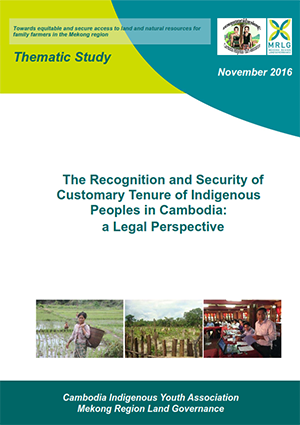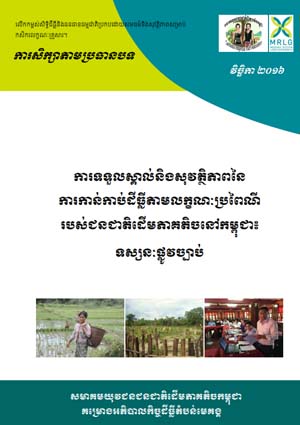Location
The indigenous people in Cambodia are living in the remote areas and highlands of Cambodia, especially in the Northeast of Cambodia, including Ratanakiri, Mondulkiri, Kratie, and Preh Vihear, and in the southwest along the cardamom mountains. These provinces are located far from Phnom Penh, the capital of Cambodia. The infrastructures in these locations are very poor, but they are rich in natural resources. Migration and economical development in other parts of Cambodia have all most negatively impacted the Indigenous Peoples security of land and natural resource use management, such as illegal logging, non-participatory concession, and land encroachment. Furthermore, these provinces are poor in accessing information and other public services like education and health, which (limits Indigenous People’s capacity to manage internal and external problems they are experiencing concerning these issues).
The education for indigenous people is very poor in general (Indigenous Peoples ability to access education at all levels is extremely low). However, with the support of humanity program(s) and individual sponsors some indigenous youths have been able to retrieve funding to study in Phnom Penh. Apart from their study, they have been actively involved with additional supportive organizations (e.g UNDP, EWMI, ILO, CLEC and NGO Forum) in their program implementation as volunteers. Some members working in organizations related to indigenous issues and the youths themselves came together and initiated the organization of indigenous youths as an association, so that they will be able to build their capacity as well become more fully involved with indigenous development programs.
CIYA was established by a group of Cambodian Indigenous Students in Phnom Penh in 2005 and was officially recognized by the Royal Government of Cambodia in 2008 with support from HBF. It is the first organization established for indigenous youth and the third indigenous organization established in Cambodia. The original purpose of the development of CIYA was to mobilize indigenous youth as a strong group in which the members could help support each other by acting as a social network in the city, as well as to build their capacity towards working as indigenous community development workers in the future. As the number of indigenous students in Phnom Penh increase, the members of CIYA also increase which also expands out to the provinces, particularly in North and Northeast Cambodia. CIYA has more than 100 members, approximately 30 of which are involved in all CIYA activities and the remainders are based and work in the provincial areas.
From 2009, with the support of the Heinrich Böll Foundation (HBF), CIYA was granted an office work area and a strong operation unit to support to the association programs and its members. International and national consultants have been recruited to help this new organization develop its own strategies with full participation from its members and partner organization, such as the NGO Forum, CLEC, UNDP, ILO, ICSO, MVI, VFC, etc. In 2010, HBF has provided a small grant to support the core fund of the organization as well as some field activities such as, providing awareness raising on legislatives related to indigenous community people livelihood including land and forestry laws to the community people in their village through the community dialogue, conduct surveys to gather statistics of the indigenous youths, especially the youths at schools, documentation of the custom and traditions of the indigenous people. HBF has also provided support to build the capacity of the operation unit of the association including organization of the full assembly, build up the management system of staff, administration and finance.
CIYA’s strategy plan has a strong focus on helping to improve indigenous youth’s access to education and abilities to gain further professional experience, whilst still upholding the importance of their custom and traditions. This includes schemes such as seeking university scholarship opportunities for CIYA members as well as internship placements at other non-governmental organizations, helping to increase the level of participation and completion of primary and secondary school by indigenous youths in the provinces, advocate indigenous people’s rights to be fully recognized by the government and their policies , help indigenous people maintain their identities , native language, culture, beliefs and custom which will collectively contribute towards helping to improve their livelihoods . CIYA currently is seeking more funds to fulfill its objectives from interested donors as well as other development partner organizations.
Members:
Resources
Displaying 1 - 3 of 3The Recognition and Security of Customary Tenure of Indigenous Peoples in Cambodia: a Legal Perspective
This short thematic study challenges the assumption that the legal framework to recognize and protect indigenous peoples’ (IP) customary lands is adequate and that the challenge lies in its implementation. With support from MRLG, a core group of IP NGOs of the Cambodia Indigenous Peoples Alliance (CIPA) held a series of seminars to scrutinize this legal framework, identify gaps and make recommendations for a revision of the supporting legal framework. The thematic study documents this joint reflection.
The Recognition and Security of Customary Tenure of Indigenous Peoples in Cambodia: a Legal Perspective (in Khmer)
This short thematic study challenges the assumption that the legal framework to recognize and protect indigenous peoples’ (IP) customary lands is adequate and that the challenge lies in its implementation. With support from MRLG, a core group of IP NGOs of the Cambodia Indigenous Peoples Alliance (CIPA) held a series of seminars to scrutinize this legal framework, identify gaps and make recommendations for a revision of the supporting legal framework. The thematic study documents this joint reflection.
Redesign of proposal Lantmäteriet - Redesign
General
The Swedish Land administration authority, Lantmäteriet, is with this small intervention given the assignment to redisgn their ITP proposal, and to integrate a thorough gender perspective into the design, with the support of a consultant.




